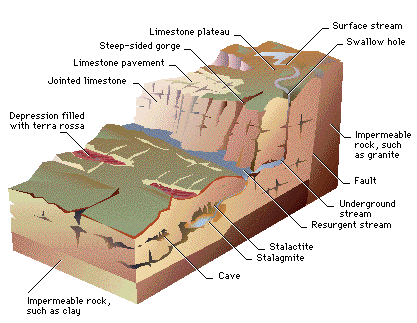
Welcome to
Annie's Caving Pages
What is Caving?
Cave exploring, or caving, is the recreational companion of speleology, which is the scientific study of natural caves. Caving enthusiasts call themselves "cavers", rather than "spelunkers" which is a term often used by noncavers.
Interest in caving is growing, partially due to the continuing concern for health, fitness and the environment, and a growing demand for outdoor experiences with an educational purpose. Perhaps the caver's greatest motivation is the thrill of original discovery. The remotest corners of the globe have been observed by satellite technology, yet there is no alternative to personal investigation of caves. Most cavers are drawn by the potential for discovering new caves or finding new extensions to known caves, but some simply enjoy the solitude and beauty of the underground wilderness. Others enjoy the camaraderie of caving, which can be a rewarding group activity as the physical and technical challenges can demand concentrated team work.
For some, caves are objects of study, to be entered as much for scientific examination of underground features as for pleasure. Natural caves may be studied for their archaeology, ecology, biology, cartography, history, geology and hydrology, to name but a few research disciplines.
Hazards can include flooding, rock instability, falls, getting stuck, getting lost, light failure, exhaustion, and hypothermia. Depending on the level of difficulty and the length of the cave visited, caving can be a strenuous activity requiring reasonably good fitness and health. Casual exploration of simple horizontal or semihorizontal caves requires some equipment besides warm clothing. A good, reliable light with at least two backup sources ensures your exit and helps you see the cave's features and your footing on uneven floors. A helmet protects you from low ceilings and falling rocks. Sturdy boots are needed in slippery conditions and to give you ankle support, and if you are more adventurous, hands-and-knees situations require gloves, knee pads and additional protective clothing such as coveralls. More advanced caving involving the safe negotiation of vertical drops requires specialized ropes and equipment and the knowledge and experience required to use them properly. To ensure safe, enjoyable experience, prospective cavers are encouraged to join a caving club or take one of the courses offered by some organizations (such as the Karst Field Studies Program, Center for Cave and Karst Studies). Remember, never go caving alone... and always inform someone of your plans!
Cave environments can be very fragile. For this reason, cavers follow a basic code of conduct to maintain the caves for future visitors:
*Do not litter or mark the caves.
*Do not disturb crickets, spiders or other forms of life.
*Do not touch cave formations.
What is Karst?
Karst is a distinctive topography in which the landscape is largely shaped by the dissolving action of water on carbonate bedrock (usually limestone, dolomite, or marble). This geological process, occurring over many thousands of years, results in unusual surface and subsurface features ranging from sinkholes, vertical shafts, disappearing streams, and springs, to complex underground drainage systems and caves.
The process of karst formation involves the interaction of water and carbon dioxide. As rain falls through the atmosphere, it picks up CO2 which dissolves in the droplets. Once the rain hits the ground, it percolates through the soil and picks up more CO2 to form a weak solution of carbonic acid: H2O+CO2=H2CO3.
The infiltrating water naturally utilizes any cracks or crevices in the rock as gravity pulls the water underground. Over long periods, with a continuous supply of CO2 - enriched water, carbonate bedrock begins to dissolve. Openings in the bedrock increase in size and an underground drainage system begins to develop, allowing more water to pass, further accelerating the formation of karst. Eventually this leads to the development of subsurface caves.

Annie and Kevin, 2007